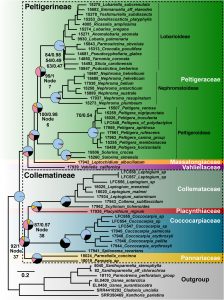Widhelm T.J., F. Grewe, B. Goffinet, M. Wedin, T. Goward, L.F. Coca, I. Distefano, A. Košuthová & H.T. Lumbsch. 2021. Phylogenomic reconstruction addressing the Peltigeralean backbone (Lecanoromycetes, Ascomycota). Fungal Diversity
110: 59–73. pdf Google scholar
Abstract reads: Rapid radiations in Fungi are only beginning to be studied with phylogenomic data. The evolutionary history of the lichenized fungal order Peltigerales has not been well resolved, particularly for the Collematineae. Here, we used concatenation and coalescent-based species tree methods to reconstruct the phylogeny of the Peltigerales based on sequences of 125 nuclear single-copy exon sequences among 60 samples, representing 58 species. Despite uneven, lineage-specific missing data and significant topological incongruence of individual exon trees, the resulting phylogenies were concordant and successfully resolved the phylogenetic relationships of the Peltigerales. Relationships in the Collematineae were defined by short branches and lower nodal support than in other parts of the tree, due in part to conflicting signal in exon trees, suggesting rapid diversification events in the early evolution of the suborder. Using tree distance measures, we were able to identify a minimum subset of exons that could reconstruct phylogenetic relationships in Peltigerales with higher support than the 125-exon dataset. Comparisons between the minimum and complete datasets in species tree inferences, bipartition analyses, and divergence time estimations displayed similar results, although the minimum dataset was characterized by higher levels of error in estimations of divergence times. Contrasting our inferences from the complete and minimum datasets to those derived from few nuclear and mitochondrial loci reveal that our topology is concordant with topologies reconstructed using the nuclear large subunit and mitochondrial small subunit ribosomal DNA markers, but the target capture datasets had much higher support values. We demonstrated how target capture approaches can effectively decipher ancient rapid radiations in cases where well resolved individual exon trees are sufficiently sampled and how to identify subsets of loci that are appropriate for fungal order-level phylogenetics.
